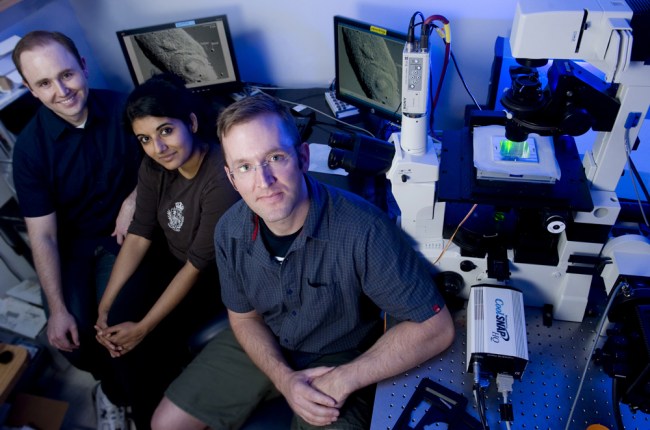
Matthew Tyska, Ph.D., right, and colleagues Russell McConnell and Rajalakshmi Nambiar, Ph.D., are studying the molecules that give cells their shapes. (photo by Joe Howell)
‘Tractor beam’ pins cell shape protein
For cells, form follows function.
“It's clear that cell shape is absolutely critical to cell function — to the ability of a cell to do its unique job,” said Matthew Tyska, Ph.D., assistant professor of Cell and Developmental Biology.
Tyska and his colleagues are exploring the molecules that give cells their shapes. They have discovered — using sophisticated technology to measure molecular-level forces — that a protein called myosin-1a acts as “glue” between the cell membrane and the internal scaffolding (the cytoskeleton).
The findings reported in the Proceedings of the National Academy of Sciences suggest that myosin-1 proteins, which are found in every cell in our bodies and in organisms as simple as amoeba, are key determinants of cell shape.
Myosin-1a, the focus of Tyska's group, is enriched in cellular structures called microvilli — finger-like protrusions on the surfaces of the epithelial cells that line the body's cavities. In the intestines, thousands of microvilli stud the surface of a single cell, and together they form a structure called the brush border.
The researchers knew from previous studies that myosin-1a's structure and location made it a good candidate for linking the cell membrane and the cytoskeleton. And they knew that elimination of myosin-1a in a knockout mouse model disrupted intestinal microvilli and caused large patches of membrane to come off the cells.
“This strongly suggested that myosin-1a was serving as a linker protein in the microvilli, and we wanted to specifically test its mechanical role,” Tyska said.
To do this, Tyska and postdoctoral fellow Rajalakshmi Nambiar, Ph.D., developed a microscope with “optical trap” technology to measure the forces at the cell membrane.
An optical trap is something like a science fiction “tractor beam,” Tyska explained.
The researchers shine an infrared laser through a microscope objective to attract and “trap” a small bead in the beam of light. They can move the trapped bead into contact with a cell and then pull it away, pulling a small bit of cell membrane (a “tether”) out from the cell. The cell pulls on the tether (“give me my membrane back!,” Tyska quips), with a measurable force that is directly related to the amount of adhesion between the cell membrane and the cytoskeleton.
With the optical trap, the investigators measured the forces required to pull membrane tethers from intestinal brush borders isolated from normal and myosin-1a knockout mice.
They found that the force required to pull tethers from cells missing myosin-1a was about 10 times less than the force required for normal cells, supporting the notion that myosin-1a plays an adhesive role.
Experiments using cultured epithelial cells strengthened these findings.
When the researchers added an inhibitor of myosin-1a to the cells, less force was required to pull a membrane tether (less adhesion between the membrane and cytoskeleton), whereas when they expressed more myosin-1a in the cells, more force was required (more adhesion).
These are some of the first mechanical measurements in live cells to implicate a particular molecule as a contributor to the force, Tyska said.
“We haven't had a great toolkit for looking at the dimension of mechanics in cell biology,” he said.
“With the optical trap, we can manipulate small beads to interact with cells and measure forces. It's really the first tool at Vanderbilt for these kinds of studies, and we think other investigators will also find it useful.”
In the intestinal brush border, where the myosin-1a “glue” is so critical to cell shape, Tyska's group showed in earlier studies that myosin-1a also played a role in the ability of the microvilli to release vesicles — small membrane “spheres” — from their tips.
In recent work featured on the cover of the Journal of Cell Biology, the researchers have extended their previous studies, which were conducted in isolated brush border samples.
They now show that microvilli release vesicles into the intestines in vivo (in mice) and that these vesicles are enriched in alkaline phosphatase, a protein that defends the host against microorganisms. Russell McConnell, a graduate student in the Tyska lab, is the first author of the paper.
The National Institutes of Health and American Heart Association supported the research.













